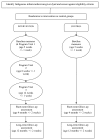The study protocol for a randomized controlled trial of a family-centred tobacco control program about environmental tobacco smoke (ETS) to reduce respiratory illness in Indigenous infants
- PMID: 20205950
- PMCID: PMC2846866
- DOI: 10.1186/1471-2458-10-114
The study protocol for a randomized controlled trial of a family-centred tobacco control program about environmental tobacco smoke (ETS) to reduce respiratory illness in Indigenous infants
Abstract
Background: Acute respiratory illness (ARI) is the most common cause of acute presentations and hospitalisations of young Indigenous children in Australia and New Zealand (NZ). Environmental tobacco smoke (ETS) from household smoking is a significant and preventable contributor to childhood ARI. This paper describes the protocol for a study which aims to test the efficacy of a family-centred tobacco control program about ETS to improve the respiratory health of Indigenous infants in Australia and New Zealand. For the purpose of this paper 'Indigenous' refers to Australia's Aboriginal and Torres Strait Islander peoples when referring to Australian Indigenous populations. In New Zealand, the term 'Indigenous' refers to Māori.
Methods/design: This study will be a parallel, randomized, controlled trial. Participants will be Indigenous women and their infants, half of whom will be randomly allocated to an 'intervention' group, who will receive the tobacco control program over three home visits in the first three months of the infant's life and half to a control group receiving 'usual care' (i.e. they will not receive the tobacco control program). Indigenous health workers will deliver the intervention, the goal of which is to reduce or eliminate infant exposure to ETS. Data collection will occur at baseline (shortly after birth) and when the infant is four months and one year of age. The primary outcome is a doctor-diagnosed, documented case of respiratory illness in participating infants.
Discussion: Interventions aimed at reducing exposure of Indigenous children to ETS have the potential for significant benefits for Indigenous communities. There is currently a dearth of evidence for the effect of tobacco control interventions to reduce children's exposure to ETS among Indigenous populations. This study will provide high-quality evidence of the efficacy of a family-centred tobacco control program on ETS to reduce respiratory illness. Outcomes of our study will be important and significant for Indigenous tobacco control in Australia and New Zealand and prevention of respiratory illness in children.
Figures


Similar articles
-
The protocol for the Be Our Ally Beat Smoking (BOABS) study, a randomised controlled trial of an intensive smoking cessation intervention in a remote Aboriginal Australian health care setting.BMC Public Health. 2012 Mar 23;12:232. doi: 10.1186/1471-2458-12-232. BMC Public Health. 2012. PMID: 22439653 Free PMC article. Clinical Trial.
-
Australian and New Zealand Indigenous mothers' report respect for smoking bans in homes.Women Birth. 2015 Mar;28(1):1-7. doi: 10.1016/j.wombi.2014.09.004. Epub 2014 Nov 8. Women Birth. 2015. PMID: 25458756
-
Effect of a family-centered, secondhand smoke intervention to reduce respiratory illness in indigenous infants in Australia and New Zealand: a randomized controlled trial.Nicotine Tob Res. 2015 Jan;17(1):48-57. doi: 10.1093/ntr/ntu128. Epub 2014 Aug 25. Nicotine Tob Res. 2015. PMID: 25156527 Free PMC article. Clinical Trial.
-
The participation of Aboriginal and Torres Strait Islander parents in Australian trials of parenting programs for improving children's health: a scoping review.Med J Aust. 2024 Apr 1;220(6):331-335. doi: 10.5694/mja2.52198. Epub 2024 Jan 8. Med J Aust. 2024. PMID: 38186285
-
Smoking and Aboriginal and Torres Strait Islander and Māori children.J Paediatr Child Health. 2010 Sep;46(9):516-20. doi: 10.1111/j.1440-1754.2010.01849.x. J Paediatr Child Health. 2010. PMID: 20854323 Review.
Cited by
-
A Qualitative Study about Creating Smoke-free Home Rules in American Indian and Alaska Native Households.J Community Health. 2019 Aug;44(4):684-693. doi: 10.1007/s10900-019-00666-1. J Community Health. 2019. PMID: 31025142 Free PMC article.
-
Risk factors for febrile respiratory illness and mono-viral infections in a semi-closed military environment: a case-control study.BMC Infect Dis. 2015 Jul 25;15:288. doi: 10.1186/s12879-015-1024-7. BMC Infect Dis. 2015. PMID: 26208494 Free PMC article.
-
Family and carer smoking control programmes for reducing children's exposure to environmental tobacco smoke.Cochrane Database Syst Rev. 2018 Jan 31;1(1):CD001746. doi: 10.1002/14651858.CD001746.pub4. Cochrane Database Syst Rev. 2018. PMID: 29383710 Free PMC article.
-
Family-centred interventions for Indigenous early childhood well-being by primary healthcare services.Cochrane Database Syst Rev. 2022 Dec 13;12(12):CD012463. doi: 10.1002/14651858.CD012463.pub2. Cochrane Database Syst Rev. 2022. PMID: 36511823 Free PMC article.
-
Effective strategies to reduce commercial tobacco use in Indigenous communities globally: A systematic review.BMC Public Health. 2016 Jan 11;16:21. doi: 10.1186/s12889-015-2645-x. BMC Public Health. 2016. PMID: 26754922 Free PMC article.
References
-
- Carville KS, Lehmann D, Hall G, Moore H, Richmond P, de Klerk N, Burgner D. Infection Is the Major Component of the Disease Burden in Aboriginal and Non-Aboriginal Australian Children: A Population-Based Study. Pediatr Infect Dis J. 2007;26:210–216. doi: 10.1097/01.inf.0000254148.09831.7f. - DOI - PubMed
-
- Robson B, Harris R. Hauora: Māori Standards of Health IV. A study of the years 2000-2005. Wellington: Wellington: Te Rōpū Rangahau Hauora a Eru Pōmare; 2007.
-
- Kwok M-K, Schooling CM, Ho L-M, Leung SL, Mak K-H, McGhee SM, Lam T-H, Leung GM. Early life second hand smoke exposure and serious infectious morbidity during the first eight years: evidence from Hong Kong's "Children of 1997" birth cohort. Tob Control. 2008;17:263–270. doi: 10.1136/tc.2007.023887. - DOI - PubMed
Publication types
MeSH terms
Substances
LinkOut - more resources
Full Text Sources
Medical
Molecular Biology Databases

